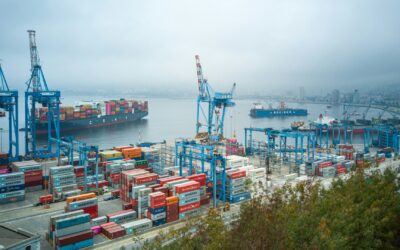Ever wonder how your SUV instrument panel comes together? An automotive Tier I supplier assembling instrument panels in Michigan has hundreds of Tier II and III suppliers. Individual suppliers represent a wide range of fluctuating supply risks within this collective supply base, manufacturing parts in far corners of the world. Global suppliers shipping inbound parts such as fasteners from China, instrument cluster electronics from South Korea and wiring harnesses from Mexico result in a just-in-time supply chain. One disruption event along this integrated lean supply chain triggers a rapid halt in vehicle production.
In today’s hyper-connected global economy, the response to supply chain risk has largely been reactive. Unmitigated risk can cause disruptions for a company’s supply chain. These are dynamic times where continuously reviewing supply chain risk is making the difference between company successes and failures. Developing a comprehensive Supply Chain Risk Assessment can help your organization identify potential failures in the supply chain. The five-step process below could prove invaluable in navigating our current two-pronged crises—the COVID-19 pandemic and 2020 recession.
The 5-Step Process
Step 1 – Select study approach
- Objective: Define the system and problems of interest, determine analysis approach type, identify the level of study
- Deliverables: A defined methodology for the supply chain failure mode analysis
Step 2 – Identify failure modes
- Objective: Divide system into logical sub-units, identify failure modes of the system, determine key input variables
- Deliverables: A list of failure modes, a list of all the way the inputs to a supply chain can fail
Step 3 – Evaluate failure modes
- Objective: Evaluate failure modes capable of producing problems, identify the causes and effects of each failure mode, determine controls currently in place
- Deliverables: A list of effects each failure will have downstream, a list of causes each failure mode can have, a list of controls in place for each failure
Step 4 – Perform quantitative analysis
- Objective: Develop severity, occurrence and detection scales, score severity, occurrence and detection for each failure mode, cause and control
- Deliverables: Severity, occurrence and detection scores across all failure modes, initial Risk Priority Number (RPN) calculation
Step 5 – Calculate risk level
- Objective: Finalize RPN calculation, prioritize risks, include risk mitigation activities, distribute results
- Deliverables: Finalized “RPN” calculations, prioritized list of supply chain failure modes based on supply chain risk
Tools Available
Several manual and automated software tools can be used to support the Supply Chain Risk Assessment process: supply chain Failure Mode Effects and Analysis (FMEA), supply chain mapping, supply chain audits, boundary diagrams, affinity diagrams, P-diagrams, etc. The identification and qualification of risk is essential in the migration from reactive to predictive risk management. Supply chain risk evaluation tools should qualify risks against specific failure modes. Risk management efforts should focus on: 1) identification of supply chain failure modes; 2) comparative likelihood of occurrence of failure; and 3) current measurement methods and controls.
Navigating Supply Chain Risk
Managing supply chain risks should occur at all levels of the supply chain, and the process should support integration with supplier and customer risk management activities. The process should be active in all stages of the acquisition lifecycle, starting with technology development and continuing through acquisition, production, maintenance, repair and disposal. The scope of the process should include all types of risks appropriate for the supply chain. In addition to the common causes of disruption, risk identification should consider economic, political, environmental, regulatory, manufacturing readiness, and technological obsolescence issues. All levels of management should be actively engaged in risk management, including strategic, business, program, technical and tactical levels. The process should both leverage traditional tools for assessing risk, but also involve new specific SCM mitigation software tools and services solutions.
Understanding the risks within a supply chain requires an in-depth knowledge of business operations. To develop this understanding, the company must begin with interviews and workshops typically involving a cross-functional team of subject matter experts representing sourcing, manufacturing and logistics. The company must collect its financial and risk performance data (e.g., average lead times, safety stock levels, other inventory levels, etc.) and benchmark it against industry and functional comparisons. This process enables the organization to develop a detailed picture of its supply chain, which in turn helps it identify potential risks more easily.
The above Supply Chain Risk Assessment five-step process favors a more formal, structured process for managing risk. Analyzing supply chain risk must be a cross-functional process that involves senior management as well as key stakeholders from finance, operations, internal audit, and risk management. Leaders need to move beyond managed risks within functional areas. The most effective forms of risk management demands involvement across multiple areas of the organization. Today, more than ever, leaders need to adopt a boundary spanning Supply Chain Risk Management strategy to position their companies to thrive in a predictably unpredictable world.
William Crane, CEO of IndustryStar, an Ann Arbor, Michigan-based on-demand supply chain services and software technology company that partners with mobility leaders to reduce the cost, time and risk of bringing new vehicles, modules and components to market. William is a trusted advisor in supply chain with demonstrated results starting, launching and enhancing procurement, logistics, supplier quality and manufacturing organizations. His work has appeared frequently in the Institute for Supply Management, Sourcing Industry Group, Disruptor.com and Modern Material Handling. William’s passion for bringing technologies to market that have a positive impact on the world can be found via his blog Supply Chain for Tomorrow’s Technology. William is also Host of the Supply Chain Innovation podcast where he interviews top change-makers to uncover strategies, tips, and tools for improving new product launches.




